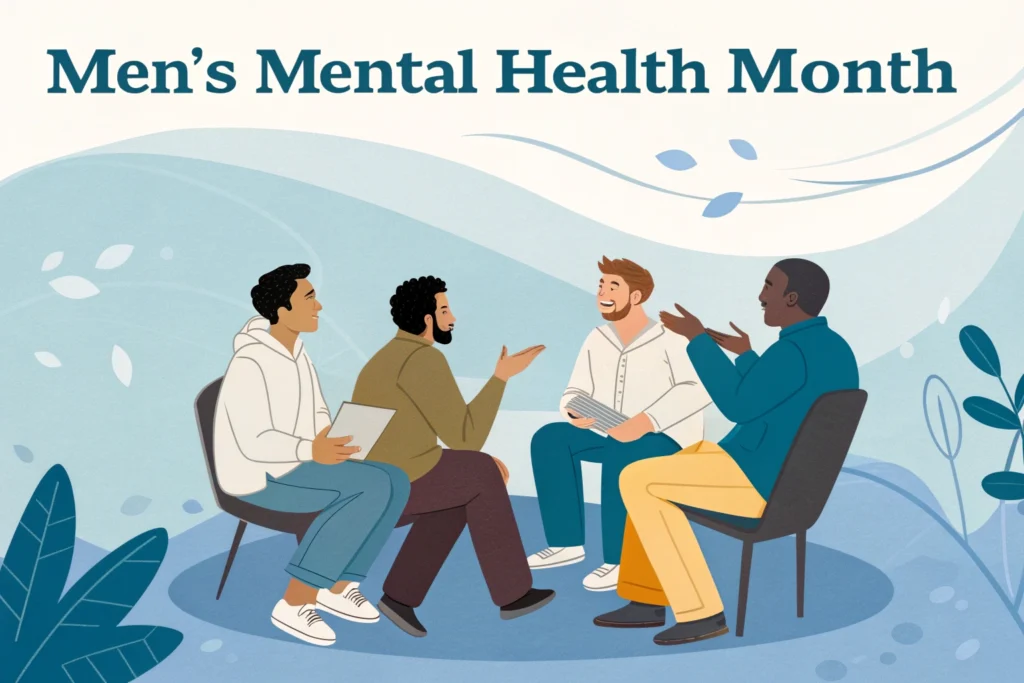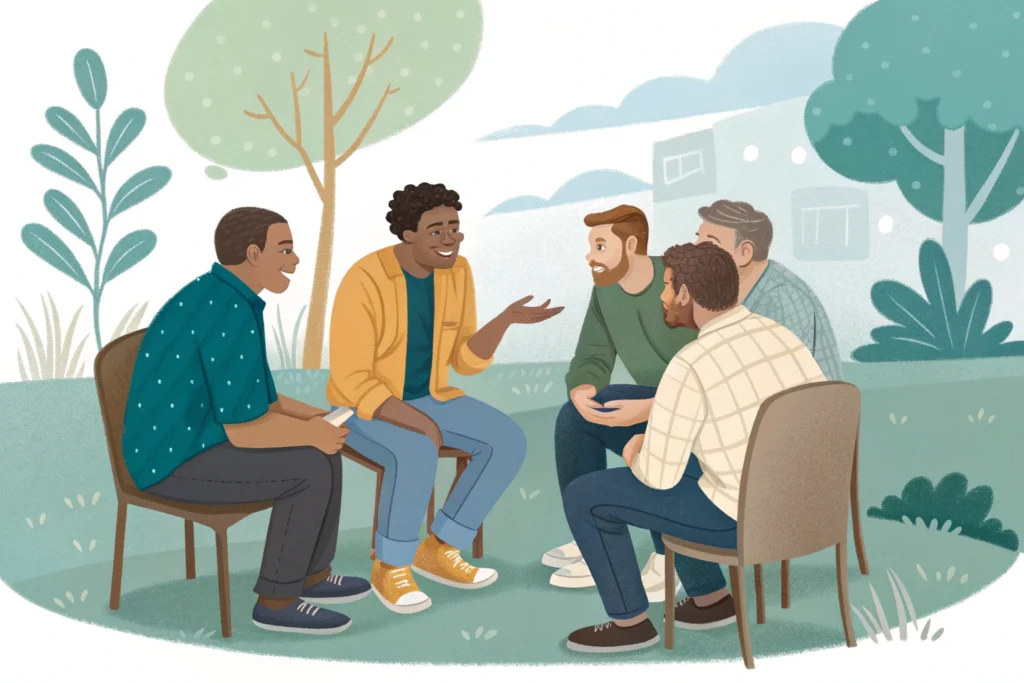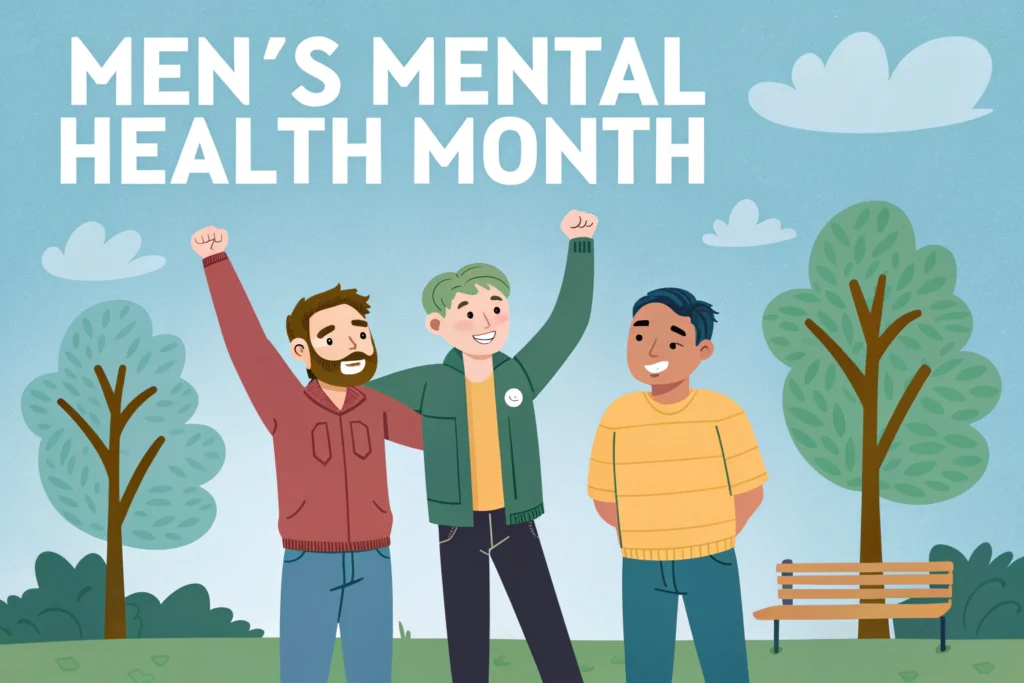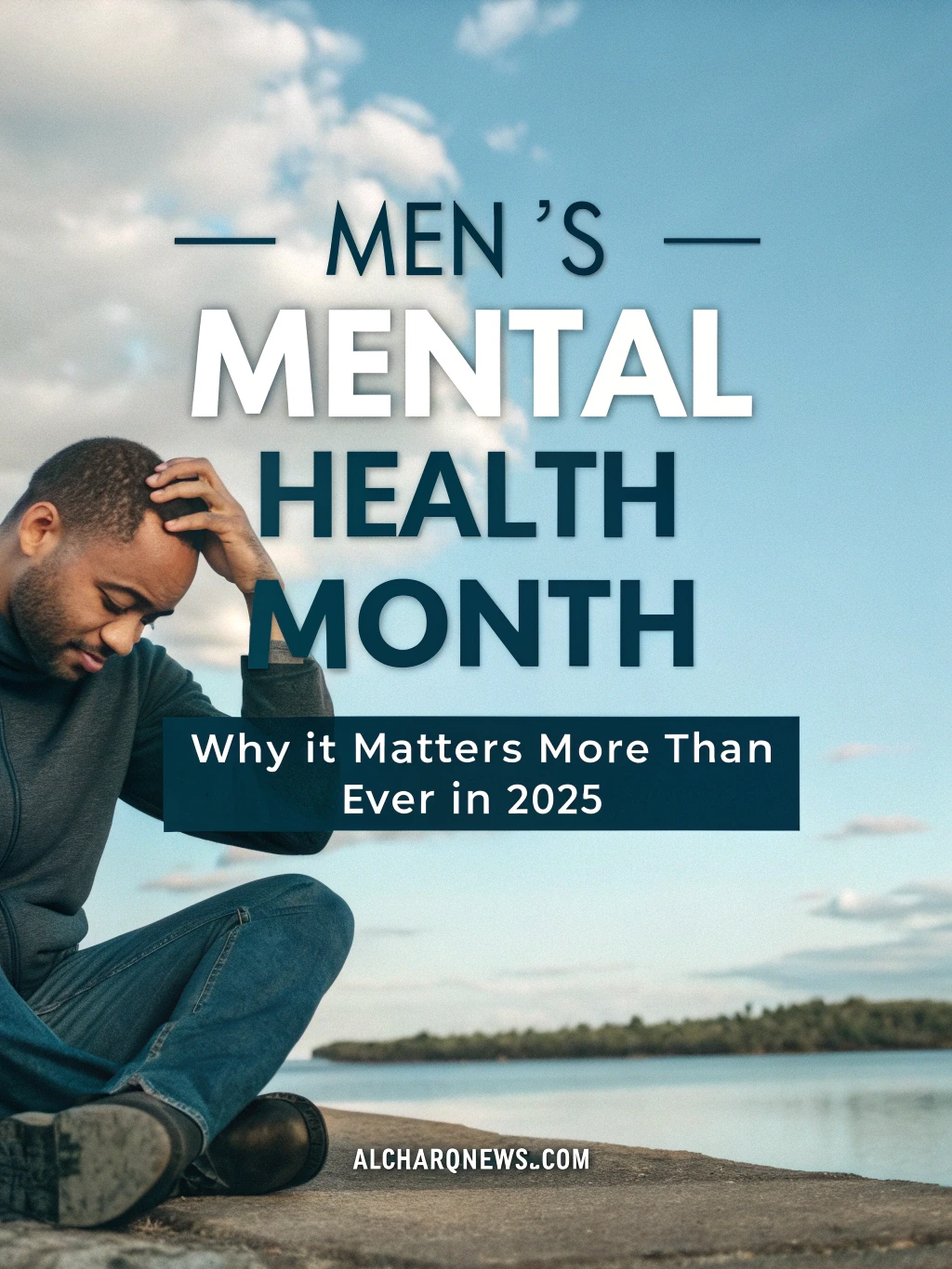It was 2:17 AM when my phone lit up with a text from my brother: “You up?” Those two simple words masked a deeper cry for help that I nearly missed. For months, he had been battling depression silently, wearing the mask of “I’m fine” that so many men feel obligated to maintain. It wasn’t until that late-night message that the walls finally began to crumble.
As we approach Men’s Mental Health Month in 2025, stories like my brother’s remind us why this observance isn’t just another awareness campaign—it’s a lifeline for millions who continue to suffer in silence. With mental health challenges reaching unprecedented levels in the post-pandemic era, the conversation about men’s unique struggles with mental wellbeing has never been more urgent or necessary.
The statistics remain alarming: men die by suicide at rates nearly four times higher than women, yet they’re significantly less likely to seek professional help. Behind these numbers are fathers, brothers, partners, and friends whose struggles often go unnoticed until reaching crisis points. This disconnect between need and support forms the heart of why Men’s Mental Health Month matters more than ever in 2025.
Table of contents

The Evolution of Men’s Mental Health Month
Historical Context and Origins
Men’s Mental Health Month emerged in the early 2010s as mental health advocates recognized the need for targeted outreach to a demographic notoriously resistant to discussing psychological struggles. What began as scattered grassroots efforts eventually coalesced into a coordinated June observance, complementing the broader Mental Health Awareness Month in May.
Organizations like the Movember Foundation, originally focused on physical health issues like prostate cancer, expanded their mission to include mental health awareness after recognizing the silent epidemic affecting their male constituencies. Their early campaigns helped normalize conversations about depression, anxiety, and suicide prevention specifically among men.
By 2025, what started as a small movement has transformed into a substantial platform for change, with governmental recognition, corporate sponsorships, and widespread media coverage amplifying its message. The evolution reflects a growing understanding that men’s mental health represents not just an individual concern but a public health priority requiring collective action.
The 2025 Landscape
The mental health landscape you’re navigating in 2025 bears the unmistakable imprint of the past five years’ global challenges. Post-pandemic research confirms what many mental health professionals suspected: COVID-19 created a long-tail crisis that continues to affect psychological wellbeing, with men showing particular vulnerability to its economic and social aftereffects.
Recent data from the National Institute of Mental Health reveals a 27% increase in reported anxiety symptoms among men since 2020, while depression diagnoses have risen by 23%. These numbers likely represent just the tip of the iceberg, as traditional measurement tools often miss how mental distress manifests differently in male populations.
Encouragingly, cultural narratives around masculinity have begun shifting. Media representations increasingly showcase mental health struggles as part of complete masculine identities rather than weaknesses to be overcome. Celebrities, athletes, and business leaders opening up about their own mental health journeys have helped create permission spaces for everyday men to do the same.
Policy developments reflect this evolving understanding, with workplace mental health protections strengthened and insurance parity requirements better enforced. Telehealth advancements have removed some access barriers, though significant gaps remain, particularly for rural and socioeconomically disadvantaged men.
Understanding the Crisis: Current Statistics and Trends
Alarming Numbers Behind Men’s Mental Health
The raw data paints a sobering picture of men’s mental health in 2025:
- Men account for 78% of all suicide deaths in the United States, with similar patterns worldwide
- Only 1 in 4 men who experience depression will seek professional help, compared to 1 in 2 women
- Mental health conditions often manifest differently in men, leading to underdiagnosis and misdiagnosis
- Substance abuse disorders occur at roughly twice the rate among men with untreated mental health conditions
- Work-related burnout affects 42% of working men, with highest rates among those in male-dominated industries
These statistics reflect multiple factors working against men’s mental wellbeing: stigma against help-seeking, diagnostic criteria that may not capture male presentation of mental distress, and cultural expectations that valorize stoicism and self-reliance above emotional vulnerability.
Pandemic Aftermath: The Long Tail of COVID-19
Five years after the height of the pandemic, its psychological ripple effects continue to shape mental health outcomes. For many men, COVID-19 created a perfect storm of stressors: economic insecurity, disrupted routines, social isolation, and health anxieties.
Research from the Stanford Center for Population Mental Health found that men who experienced job loss or financial instability during the pandemic show elevated rates of depression and anxiety even years later. This economic impact hits particularly hard against cultural expectations that tie male identity to provider roles.
The pandemic also fundamentally altered workplace dynamics, with remote and hybrid models becoming standard in many industries. While offering flexibility, these arrangements often reduced the casual social connections that previously provided informal support systems for many men. Without water cooler conversations and after-work activities, subtle signs of struggle became easier to miss.
Yet amid these challenges, the pandemic also catalyzed positive changes. Teletherapy removed access barriers for many, while normalized conversations about collective mental health reduced some stigma. The shared experience created unprecedented openness about psychological vulnerability, opening doors for men previously reluctant to acknowledge their struggles.
The Masculinity Factor: Cultural Barriers to Seeking Help
Traditional Masculinity and Mental Health Stigma
At the core of men’s mental health challenges lies a complex relationship between traditional masculine norms and help-seeking behavior. Research consistently shows that men who strongly adhere to conventional masculine ideals—emotional stoicism, self-reliance, strength, control—are significantly less likely to seek mental health support when struggling.
These cultural expectations begin forming in childhood, when boys often receive messages that emotions—particularly vulnerability, sadness, and fear—represent weakness. By adulthood, many men have internalized these beliefs so deeply that acknowledging mental health struggles feels like a fundamental threat to their identity.
Media depictions have historically reinforced these stereotypes, though 2025 shows promising evolution in portrayals of masculine emotional expression. Popular culture increasingly features men navigating mental health challenges while maintaining their essential strength—redefining resilience to include asking for help rather than suffering silently.
Generational differences reveal encouraging trends, with younger men generally showing greater comfort discussing mental health concerns. However, this varies significantly across cultural and socioeconomic backgrounds, with traditional masculinity norms remaining particularly strong in certain communities.
The Language Gap: How Men Express Mental Distress
One crucial barrier to addressing men’s mental health involves recognition—both self-recognition and external identification of problems. Mental health conditions often manifest differently in men than the textbook descriptions primarily based on female presentation.
While women more frequently report feeling sad or anxious, men experiencing depression might describe:
- Feeling irritable, angry, or aggressive
- Increased risk-taking behaviors
- Physical complaints like headaches, digestive issues, or chronic pain
- Fatigue and sleep disturbances
- Difficulty concentrating on work or hobbies
- Increased alcohol or substance use
- Withdrawal from relationships or overcommitment to work
Healthcare providers not trained to recognize these alternative expressions may miss depression or anxiety in male patients. Similarly, diagnostic questionnaires often emphasize emotional symptoms over behavioral or physical manifestations more common in men.
This language gap extends to how men communicate distress to friends and family. Rather than directly expressing emotional pain, struggling men might show subtle behavioral changes or make oblique references to difficulties. Learning to recognize these signals represents a crucial step in supporting men’s mental health.

Special Focus: Vulnerable Demographics in 2025
Young Men and Digital Mental Health
For men under 30, the digital landscape presents both unprecedented challenges and innovative solutions for mental wellbeing. Growing up in an always-connected environment has created unique pressures, with social media comparison and digital performance anxiety contributing to record levels of depression and anxiety.
Recent studies show young men spending an average of 7.3 hours daily on screens, with correlations between excessive social media use and negative mental health outcomes. The curated nature of online personas creates unrealistic comparison points, while anonymous environments can foster both supportive communities and destructive influences.
Gaming communities represent particularly complex spaces for young men’s mental health. While offering valuable social connection—especially during pandemic isolation—gaming environments sometimes reinforce problematic expressions of masculinity. However, innovative mental health organizations have begun establishing presences within gaming platforms, meeting young men where they already gather.
Digital literacy increasingly correlates with mental health outcomes, with those possessing stronger critical evaluation skills showing greater resilience against online harms. Educational initiatives integrating digital wellness alongside traditional mental health literacy show promising early results.
Men of Color: Intersectionality and Mental Health
For men of color, mental health challenges intersect with systemic racism, creating compound stressors and unique barriers to care. Black men face discrimination within healthcare systems while navigating societal stereotypes that often pathologize normal emotional responses to racism. Latino men may encounter language barriers and cultural stigma around mental health discussions. Asian American men report some of the lowest rates of mental health service utilization despite significant need.
Access disparities remain stark in 2025, with men of color having approximately 30% less access to mental health services than their white counterparts. Even when services are theoretically available, cultural competency issues create additional barriers, with many men of color reporting previous negative experiences with providers who misunderstood cultural contexts.
Community-based approaches show the most promise in addressing these disparities. Barber shop initiatives, faith-based programs, and culturally specific support groups have demonstrated success by embedding mental health resources within trusted community spaces. Organizations led by people of color tend to achieve higher engagement rates and better outcomes through authentic understanding of cultural nuances.
LGBTQ+ Men: Navigating Multiple Identities
Men identifying as LGBTQ+ face unique mental health challenges stemming from navigating both masculine expectations and sexual/gender minority stress. Research consistently shows higher rates of depression, anxiety, and suicidality among this population, with transgender men facing particularly severe disparities.
Compound stigma creates additional help-seeking barriers, as many LGBTQ+ men report previous negative experiences with healthcare systems. Finding providers knowledgeable about specific LGBTQ+ concerns remains challenging, especially outside major urban centers.
Progress in specialized care options shows promising developments by 2025, with increased availability of LGBTQ+-affirming therapists and telehealth options connecting rural LGBTQ+ men with appropriate resources. Peer support networks—both virtual and in-person—have expanded significantly, creating vital community connections that buffer against minority stress.
Identity affirmation strongly correlates with positive mental health outcomes, with LGBTQ+ men who feel accepted in their identities showing significantly lower rates of depression and suicidality. This underscores the importance of societal acceptance alongside clinical interventions.
Aging Men: The Overlooked Demographic
Men over 65 represent one of the highest-risk groups for mental health crises yet receive disproportionately less attention in awareness campaigns. Retirement transitions often trigger identity challenges as careers that defined self-worth conclude. Social networks naturally contract with age, creating isolation risks particularly acute for older men, who typically maintain smaller social circles than women throughout life.
The connection between cognitive health and emotional wellbeing becomes increasingly significant with age. Depression can sometimes be mistaken for early dementia, while actual cognitive decline often triggers depression—a complex interplay requiring specialized attention often lacking in general mental health settings.
Intergenerational support models show particular promise for addressing older men’s mental health needs. Programs connecting seniors with younger community members for mentorship, skill-sharing, and companionship address isolation while creating purposeful roles that support identity and meaning after retirement.
Effective Interventions: What’s Working in 2025
Clinical Approaches Gaining Traction
Traditional therapy models have evolved significantly to better engage male clients. Problem-focused approaches emphasizing concrete solutions over open-ended emotional exploration often show higher retention rates among men. Activity-based therapeutic models—walking therapy, sports psychology, and wilderness interventions—create contexts where therapeutic conversations feel more natural for many men.
Telehealth developments have removed significant barriers for men historically reluctant to be seen entering mental health clinics. Anonymous initial consultations and digital screening tools allow men to explore concerns privately before committing to treatment. The normalizing effect of accessing care from personal spaces rather than clinical environments has proven particularly valuable.
Medication approaches have become more nuanced, with increasing recognition of how antidepressants and anti-anxiety medications may affect men differently than women. Integrative approaches combining medication with lifestyle modifications show promising outcomes, particularly when framed within overall health rather than isolated as mental health interventions.
Community-Based Solutions
Some of the most effective men’s mental health initiatives operate entirely outside clinical settings. “Men’s sheds”—community spaces where men gather around shared projects and activities—have expanded from their Australian origins to global adoption. These environments foster natural conversations about wellbeing while building supportive connections through side-by-side activities rather than face-to-face discussions that many men find uncomfortable.
Workplace programs represent another crucial intervention point, with organizational mental health initiatives showing significant return on investment through reduced absenteeism and improved productivity. Companies implementing regular check-ins, mental health days, and normalized discussion of psychological wellbeing report measurably improved outcomes among male employees.
Sports and fitness communities increasingly incorporate mental wellness alongside physical training. From professional leagues implementing mandatory mental health screenings to local gyms hosting support groups, athletic spaces are transforming from environments that sometimes reinforced unhealthy masculine stoicism to venues promoting integrated wellbeing.
Comparison: Mental Health Resources Then and Now
| Aspect | Pre-2020 Landscape | 2025 Landscape |
|---|---|---|
| Therapy Modalities | Traditional talk therapy dominant | Activity-based, solution-focused, and digital options widely available |
| Access Points | Primarily clinical settings | Multiple entry points: digital, community, workplace, fitness centers |
| Insurance Coverage | Limited mental health parity | Expanded coverage with telehealth options |
| Screening Approaches | Generic mental health screenings | Gender-specific assessments recognizing male presentation |
| Public Awareness | Primarily focused on crisis | Expanded to include prevention and maintenance |
| Cultural Representation | Limited diversity in messaging | Culturally specific approaches and messaging |
| Technology Integration | Basic apps and websites | AI-assisted tools, VR therapy, advanced monitoring |
Taking Action: How to Support Men’s Mental Health Month 2025
Individual-Level Action Steps
This Men’s Mental Health Month, consider taking these concrete steps to support yourself and the men in your life:
- Learn to recognize warning signs specifically in how men express distress—irritability, withdrawal, increased substance use, or physical complaints often signal underlying mental health challenges.
- Initiate conversations strategically—side-by-side activities like driving, walking, or watching sports often create more comfortable settings for meaningful discussions than face-to-face confrontations.
- Develop mental health literacy through resources specifically addressing male experiences with conditions like depression, anxiety, and suicidal ideation.
- Model healthy coping by being open about your own stress management strategies and normalizing appropriate help-seeking behaviors.
- Know available resources including crisis lines, online screening tools, and local services tailored to men’s needs.
Community-Level Initiatives
Communities play crucial roles in changing mental health culture for men:
- Organize awareness events that specifically target men’s experiences, using venues and formats attractive to male audiences.
- Create male-friendly spaces for mental health discussions that align with how men naturally communicate and connect.
- Train community leaders in recognizing signs of struggle and appropriate response strategies, particularly those with natural access to men (coaches, employers, religious leaders).
- Implement screening programs in non-traditional settings like barbershops, gyms, and workplaces where men regularly gather.
- Advocate for policy changes addressing systemic barriers to mental healthcare access and quality.

Conclusion: A Call to Collective Action
Men’s Mental Health Month 2025 arrives at a critical juncture where awareness is growing but action still lags behind need. As we’ve explored throughout this article, the unique challenges men face in acknowledging and addressing mental health concerns require equally unique solutions. The statistics remain sobering, but the expanding array of resources, evolving cultural narratives, and innovative approaches offer genuine hope.
Perhaps the most powerful change has been the growing number of men willing to share their stories openly, creating permission for others to do the same. Every conversation that normalizes men’s mental health struggles helps dismantle generations of silence and stigma. Your voice, your story, your willingness to both speak and listen can contribute to this transformation.
This Men’s Mental Health Month, commit to moving beyond awareness alone and toward concrete action. Check in with the men in your life—not with general “how are you?” questions easily deflected, but with specific, caring inquiries about stress, sleep, mood, and coping. Share information about available resources. Model openness about your own challenges. Most importantly, reinforce that reaching out represents strength rather than weakness.
The cultural shift around men’s mental health requires collective effort—from individuals, communities, healthcare systems, and society at large. By challenging outdated notions of masculinity that equate emotional stoicism with strength, we create space for more authentic, connected, and psychologically healthy expressions of manhood. Our brothers, fathers, sons, friends, and colleagues deserve nothing less than our full commitment to this transformation.
Will you join the movement this Men’s Mental Health Month? The conversation that saves a life might be one you start.
Frequently Asked Questions About Men’s Mental Health Month
When is Men’s Mental Health Month observed in 2025?
Men’s Mental Health Month is observed throughout June 2025, providing a dedicated time to focus on the unique mental health challenges and needs of men while promoting resources and breaking down stigma.
Why do we need a separate Men’s Mental Health Month when there’s already Mental Health Awareness Month?
While Mental Health Awareness Month in May addresses broader mental health concerns, Men’s Mental Health Month specifically targets the unique cultural, social, and biological factors that affect men’s willingness to seek help and their expression of mental health symptoms, which often differ from women’s experiences.
What are the warning signs of mental health struggles that might present differently in men?
During Men’s Mental Health Month, it’s important to recognize that men often show signs of mental health challenges through irritability, anger, increased risk-taking, substance use, physical complaints, or workaholism rather than through sadness or anxiety that might be more readily identified as mental health issues.
How can I support a man who might be struggling with mental health issues?
Men’s Mental Health Month emphasizes practical support approaches: initiate conversations in low-pressure settings (like while driving or during an activity), use concrete rather than emotional language, respect autonomy while offering resources, normalize help-seeking with personal examples, and be consistently present without pressure.
What resources are specifically designed for men’s mental health needs?
During Men’s Mental Health Month 2025, highlight specialized resources including HeadsUpGuys, Man Therapy, the Men’s Health Forum, activity-based support groups, sports-oriented mental health programs, and male-specific online communities that provide anonymous support tailored to men’s communication preferences.
How is Men’s Mental Health Month addressing diversity within the male experience?
Men’s Mental Health Month 2025 features targeted initiatives addressing the intersectional challenges faced by various groups including men of color, LGBTQ+ men, veterans, rural men, and men from different socioeconomic backgrounds, recognizing that masculinity and mental health experiences vary significantly across these demographics.

